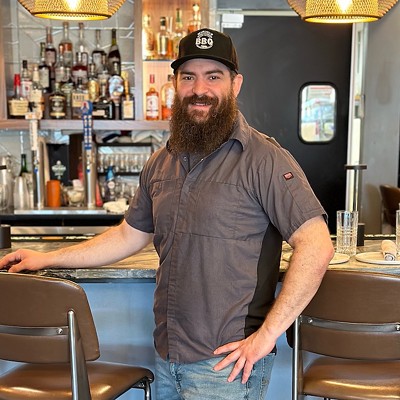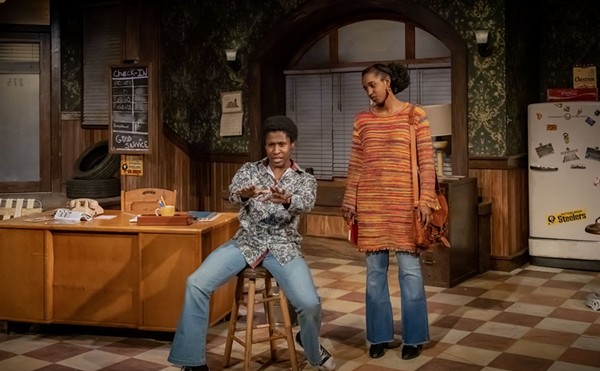In the Middle of the Way -- It's hard to say whether the problems with Anna Konik's video project are intentional. If they are, Konik needs a sharper editor; if not, all she really needs is some technical assistance. Konik, a Polish artist participating in Spaces' World Artist Program, shadows Clevelanders who are homeless or otherwise overlooked by society, trailing them with a video camera as they work soul-crushing jobs and pausing to reflect on their lives. "The most dangerous thing is not knowing where you stand on this earth," one man, a parking-lot attendant, observes. An often jarring constant is the disparity between her subjects and the wealthier folk going about their business around them. As she pans along a deserted West Sixth Street, late at night, Konik also conveys a palpable sense of the cold and danger homeless people experience daily. Her camera hand, however, is amateurishly unsteady, and her lens is nearly always out of focus. Worse, the sound is poor, which leaves many of Konik's questions and the answers she receives unintelligible. This is highly unsatisfactory in a film that is at heart a documentary. It's too bad. Konik seems to be asking good questions. She's just not asking them coherently. Through November 30 at Spaces, 2220 Superior Viaduct, 216-621-2314, www.spacesgallery.org. -- Zachary Lewis
Multiplicity -- Minimalism may not be a particularly deep aesthetic concept, but it has inspired some stunning visual work in this show, where patterns formed by otherwise mundane pieces yield large, viscerally moving creations in a variety of media. Sarah Chokyi Bauer's video of herself performing a repetitive Buddhist ceremony (flopping to the floor, standing up again) gets dull fast, but the two accompanying wall-size compilations of the individual film frames offer a beautiful experience enriched by subtle gradations in light from daytime to darkness. Each of Danielle Julian-Norton's pressed-rice boats, meanwhile, is a wonder unto itself, but dozens of them suspended from the ceiling (in "Treading and Transport") form something else altogether: a terrain that's weightless and fragile, but also faintly imposing. In the work of Patrick Gabler, small, inky-black curlicues painted in circles on huge paper scrolls become giant, feathery-textured planets with orbiting moons. Loren Schwerd's "Loveseat" consists of two wicker-bottomed chairs connected at their seats with long, woven strands of hair. It doesn't exactly fit the show's theme, but it's so creative, it hardly matters. Through January 6 at Spaces, 2220 Superior Viaduct, 216-621-2314, www.spacesgallery.org. -- Lewis
ONGOING
Christopher Duffy: Do I Know You? -- There's a giant electric contraption slowly spinning fragments of mirror in a jar, like ice cubes in a glass; images created using sheets of paper as oversized cigarette filters; a messy but inert machine that sucks up paint and turns it into piles of red, yellow, and orange spaghetti -- these are the brilliant, Seussian fruits of Christopher Duffy's imagination. How seriously to take them is up to you; this writer, for one, can't see anything profound in them. A Chicago native who has lived and worked in Cleveland for years, Duffy has a long-standing interest in dynamic glass and mixed-media sculpture, and these must represent his most elaborate creations to date. A tiny white-glass ghost with golden eyes occupies a tiny house atop a glassy green hill in "Exorcism by Oxidation" (so titled because oxidation, in theory, would render the ghost invisible). Though most of Duffy's work is playful and more or less about sensory effects, some of his fantasies are bound to leave you scratching your head. His aesthetic rationale may be shaky at times, but his technical abilities are unquestionable. Through December 4 at the Sculpture Center, 1834 E. 123rd St., 216-229-6527, www.sculpturecenter.org. -- Lewis
Design for the Modern World: The Arts and Crafts Movement in Europe and America, 1880-1920 -- The art museum's first major arts-and-crafts show in years is notable not only for its enormous size, but for the many far-flung cultures (included are works from Germany, Scandinavia, Scotland, and Hungary) that share space. But what really unites these rooms of exquisitely designed teapots, tables, chairs, lamps, jewelry, and vases is the notion that arts and crafts are anything but stylistically homogeneous: Resisting the push toward industrialism, crafts practitioners cared about design that was beautiful but functional and, above all, honest in construction. Paramount was evidence of their origin -- visible screwheads on a chair or tiny hammer marks on a silver teapot; objects with such traits, even if they were mass-produced, were deemed inherently better. Some artists, like Henry Van de Velde, who designed an entire modernist dining room for a department store, also valued affordability. The movement was a lifestyle, too, with small communes forming around these principles. The exhibit culminates in America with some elegant chairs and lamps obviously designed by Frank Lloyd Wright. There's even a nod to Cleveland's golden age of enamel. In short, Design for the Modern World renders a potentially dull subject in the most compelling manner possible. Through January 8 at the Cleveland Museum of Art, 11150 East Blvd., 216-421-7340, www.clevelandart.org. -- Lewis
Drawn to Cleveland -- More than a tribute to a generous museum patron or to the city, this group exhibition feels like a reunion. Fourteen nationally recognized artists are represented here through various works on paper. Each is connected to Cleveland, and many have shown at MOCA previously, but beyond that common experience, they've followed widely different paths. Robert Crumb's anxiety-ridden cartoons are perhaps the most famous; the best of the five examples here is his most recent, a French-themed set about consumerism called "Creeping Global Villagism," from 2004. Dana Schutz is present through three captivating black-and-white portraits of friends, whom she conveys with brutal, vaguely cubist honesty; even her self-portrait, a figure with a jack-o'-lanternlike head, is unsparing. April Gornick and Heide Fasnacht, meanwhile, wield graphite and charcoal with stunning virtuosity. Gornick's "Allee" may be the most memorable piece in the show: Using charcoal, she captures the play of light moving between groves of neatly planted trees, the horizon receding almost infinitely. Fasnacht's "Big Bang," a picture of an explosion, is pencil-drawing at its most technically accomplished, but her "Sneeze V" is truly inspired: An icky mess spews across the immense page in the form of tiny, singed punctures to the paper. Through December 30 at the Museum of Contemporary Art Cleveland, 8501 Carnegie Ave., 216-421-8671, www.mocacleveland.org. -- Lewis
Dreaming of a More Better Future -- The woman screaming on this exhibit's poster pretty much sums it up. The scenarios presented across this large, variably worthwhile display range from disturbing to chilling -- "something horribly remote and distinct from mankind," to quote Nick Rule's inky text painting at the entrance. It's too bad that Jose Krapp's well-stocked fallout shelter, called "Are We There Yet," is considered a work of art, or that Nicola Lopez's print "On the Horizon," featuring a hillside landscape densely packed with cellular towers and satellite dishes, glimpses our future reality. One work cuts extremely close to home: In Ted Savinor's "News From Tomorrow" headlines, terrorists have destroyed Disneyland and Browns Stadium. Not every prediction is terrifying; some are just depressing: "Ghost of Progress," Paul Ramirez's video of a model jet racing through a poor Mexican town underscores how wide the global economic gap is growing. There are also moments of hope: Architectural designs by Acconci Studio predict elegant, organic forms, and eclectic public protests organized by Miranda July and Harrell Fletcher suggest that at least some people are willing to take action for change. Through December 22 at the Cleveland Institute of Art, 11141 East Blvd., 216-421-7407, www.cia.edu. -- Lewis
Floating World -- Cleveland native Gary Bukovnik takes floral still lifes as close as possible to the cutting edge in this invigorating show of large-scale watercolors. Flowers, vases, water -- all disobey natural forces here, soaring freely as if dropped or thrown into view from someplace just beyond the paper's edge. The resulting sense of weightlessness is thrilling. In "Unseen Hand Frees the Sunflowers," thick stalks attached to bright yellow petals, snipped from their former bonds, cascade into the picture from above. In "Still Life Ascending," meanwhile, the complete contents of a dinner table -- a cake, vegetables, dishes, and flowers -- rush upward dynamically, as if being sucked into a vacuum. Bukovnik's other favorite perspective is extreme close-up: Looking at "Dahlia Triptych" is like sticking your face directly into a giant bouquet; its size and bold colors are almost physically overwhelming. As exciting as these conquests of gravity are, Bukovnik's finest efforts are earthbound: In "White Tulips III," for instance, there's something touching about the way exhausted-looking blooms and leaves hang limply over the edge of the vase. And Bukovnik outdoes even this in "Fallen Flowers," in which purple petals and green stems lie heavily on the floor beneath a vast field of white space. It's his version of minimalism, and it's absolutely entrancing. Through December 3 at the Bonfoey Gallery, 1710 Euclid Ave., 216-621-0178, www.bonfoey.com. -- Lewis
POPulence -- Splendor and extravagance are the defining traits of this large-scale group exhibition organized by the University of Houston Art Museum. From velvet DayGlo flowers on the floor to swooning visions in latex and acrylic on the walls, POPulence proves without question that pop art has moved into a brighter and more expansive new realm. It's tough to say who's furthest over the top, but L.C. Armstrong probably takes that honor. Her immense Hawaiian seascapes, complete with figures frolicking in the water, are almost ridiculously naive. Were it not for the frighteningly large flowers in the foreground, they might be perfect for travel brochures. Next in line is Chiho Aoshima, with her panoramic reveries about youthful aimlessness; her cute, anime-style figures drift like Japanese versions of Ophelia through scarily enchanted undersea environments fashioned out of film negatives and Plexiglas. Lacking any such narrative intent, David Reed takes graffiti art to a new level. He uses alkyd paints to create dynamic swirling lines so nearly three-dimensional, they're like liquids in motion. Kim Squaglia's colorful, multilayered combinations of latex, resin, and oil resemble Starburst chews and look good enough to eat. Then again, so do many pieces in this gloriously hedonistic exhibition. Glossy, sensuous, and full of references to contemporary culture, the whole show is candy for the eyes. Through December 30 at the Museum of Contemporary Art Cleveland, 8501 Carnegie Ave., 216-421-8671, www,mocacleveland.org. -- Lewis
Reduced to a Faulty Recollection -- It seems that painter Jeffrey Cortland Jones is at cross-purposes with himself. He successfully delights viewers with textural diversity and abstract techniques, then complicates things with an apparently biographical subtext only he can fully appreciate. He avows an interest in "damaging" and "repairing" art objects until only a "residual" version of the original remains. Whatever exactly that means, his paintings here are visually delicious, and they do seem to have been beaten up a bit. Jones employs a variety of media -- enamel, resin, acrylic, plaster -- applying them layer-by-layer in straight-edged sections within fiberboard squares. Surfaces range from smooth and marblelike to rough and jagged. Painterly gestures -- vigorous, dense hatch marks and smoke stains, usually -- are often visible beneath solid-colored topcoats. In one of his more elegant, loosely executed images, light-green waves lap calmly on an abstract beach. It's easy to imagine the emotions that inspired these pictures, but Jones doesn't trust us. Instead, he burdens his work with wordy, interchangeable titles that offer zero insight. "Between the End and Where We Live Are Words: Guilty of Deceit" is a prime example. A vaguely discernible narrative documenting a failed romance unites the exhibit. By the end, Jones is painting "A Healthy Distrust Hidden Behind Security" and "To Prove That I Can Survive Without You." Now he just needs to make one more break, between art and life. Through December 3 at E. Gordon Gallery, 2026 Murray Hill Rd., 216-795-0971, www.egordongallery.com. -- Lewis
Third Annual Juried CSU & CIA Student Exhibition -- The Edge, a gathering space for Lutheran Cleveland State students, also serves as an independent, fully secular art gallery. With this particular exhibition of student work, you'll mostly get what you pay for. And while no self-respecting professional would paint giant white tiger eyes, for instance, there are a few rather stunning exceptions. Dan Loy brilliantly adapts Picassolike cubist principles to modern sporting times in "Steroids," a painting of towel-clad baseball players horsing around in a locker room. Jason Dooley went on a Keith Haring-induced fantasy in his drawing of black, graffiti-like stick figures breaking out of a design and into free fall. A black-and-white photograph of a woman sitting on a rock amid the dwarfing beauty of a forest valley makes a positive name for Jacqueline Reasor. And Eartha Goodwin stumbled onto an interesting technique, overlaying photos of people with photos of the outdoors; large, close-up views of women's faces blend seamlessly into delicate backgrounds of trees and flowers in compositions of dignified, almost royal sadness. Calling to mind Renaissance paintings of the Virgin Mary, they're the only works here with religious overtones. Through December 2 at the Edge, 1844 Euclid Ave., 216-241-7120, www.csuohio.edu/edge. -- Lewis
Third Cleveland Biennial Exhibition -- Technical prowess, humor, and invention are in full bloom throughout this substantial crafts show, but rare is the local artist who also wields a forceful, lasting idea. One of the few is Si-Yun Chang, who deftly combines tapestry and Korean paper, nearly transparent blue squares of which suggest water in "Mirage." Her juxtaposition of bulky and wispy materials injects the piece with an ethereal quality. Contrasts are Jack Russell's forte too, but his are of the ironic variety: In "Square," small red-and-black pictures hang together to form a larger but blurry image, like an unfinished puzzle (if organized properly, they would show a circle, not a square). Many artists have woven nonfabric items into quilts, the finest example of which is Maria Zanetta's "Green Bather," a quirky mishmash of paint, textiles, beads, and paper on canvas with a cubist slant. Best in show went to Taehae Kim for "Meditation," paper-thin metallic discs and squares etched with floral patterns and pressed between sheets of clear plastic. Unusual it certainly is, and a technical feat to boot, but as an aesthetic object, it's relatively flat and dull. Matt McCormick would have been a clearer candidate: His "Wings," crumpled brown and gray petals of thick, speckled glass, should have carried him further. Through December 10 at Cleveland State University Art Gallery, 2307 Chester Ave., 216-687-2103, www.csuohio.edu/art/gallery. -- Lewis











